Photo deep space
 Bashny.Net
Bashny.Net
Since ancient times, man has sought to understand the unknown, directing his gaze at the night sky, where literally millions of stars scattered. Scientists have always paid serious attention to the study of the cosmos, and now they have the opportunity, with the help of powerful research equipment not only treat it, but also to make unique pictures. I invite you to enjoy the amazing photos of the cosmos that have been made by them recently and found some interesting facts. Separate Nebula
Beautiful triple nebula NGC 6514 in the constellation of Sagittarius. The name of the nebula suggested by William Herschel and means' divided into three lobes. " The exact distance to it is unknown, but estimates range from 2 to 9000 light years. NGC 6514 is just three basic types of nebulae - Emission (pink color), reflecting (blue) and absorbing (black color). (Photo by Máximo Ruiz):
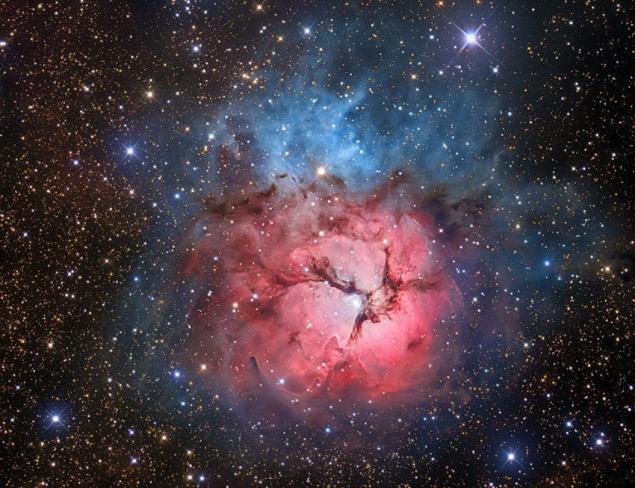
The cosmic elephant's trunk
Elephant Trunk Nebula winds through the emission nebula and young star cluster complex IC 1396 in the constellation Cepheus. Cosmic elephant's trunk is over 20 light-years. These dark clouds, like the mustache, contain material for star formation and hide protostars - stars in the final stages of its formation - the layers of cosmic dust. (Photo by Juan Lozano de Haro):
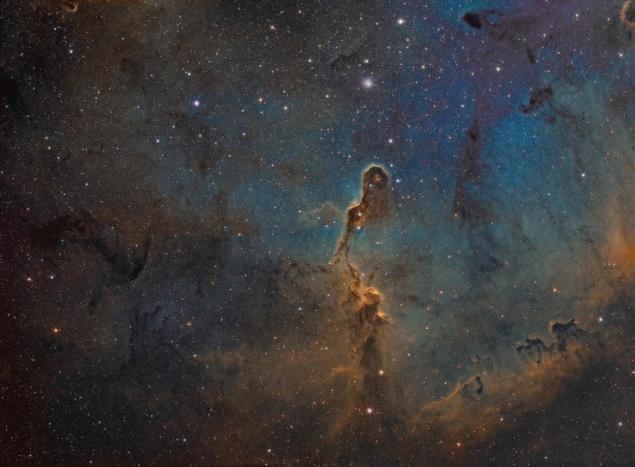
World-ring
Hoag's Object - a strange ring-shaped galaxy in the constellation Serpens, named after otkryvatelya.Rasstoyanie to Earth is about 600 million light years. In the center of the galaxy is a cluster of relatively older stars are yellow. It is surrounded by almost right ring of stars younger, with blue tint. The diameter of the galaxy - about 100 thousand. Light years. Among the hypotheses about the origin of the collisions of galaxies that happened billions of years ago. (Photo by R. Lucas (STScI | AURA), Hubble Heritage Team, NASA):
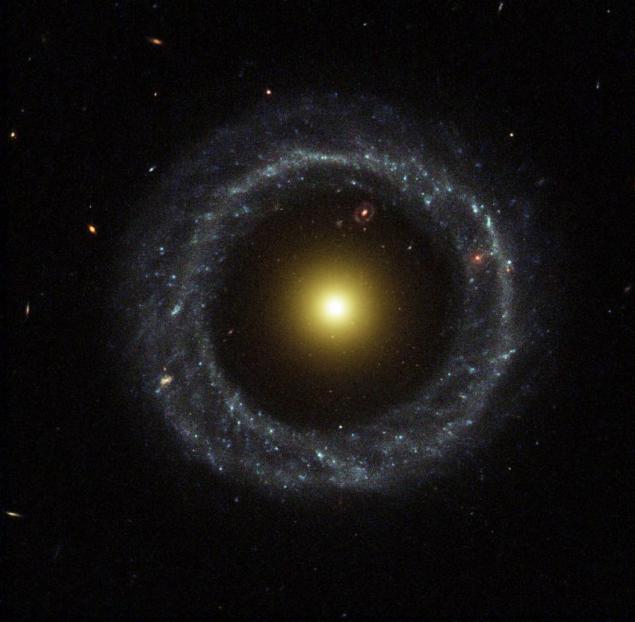
Moon Over Andromeda
A large spiral galaxy Andromeda is located only 2.5 million light-years away and is the nearest to our own Milky Way spiral galaxy. It can be seen with the naked eye as a small fuzzy patch in the sky. This composite picture compares the angular size of the Moon and the Andromeda Galaxy. (Photo by Adam Block and Tim Puckett):

The ever-changing surface of Io
Jupiter's moon Io - the most volcanically active object in the solar system. Its surface is constantly changing due to new lava flows. This photo side of Io, turned to Jupiter, it is composed of images taken in 1996 by NASA's Galileo spacecraft. The lack of impact craters because the entire surface of Io is covered with a layer of volcanic deposits much faster than the craters appear. The probable cause of volcanic activity is the changing gravitational tides caused by Jupiter huge. (Photo: Galileo Project, JPL, NASA):
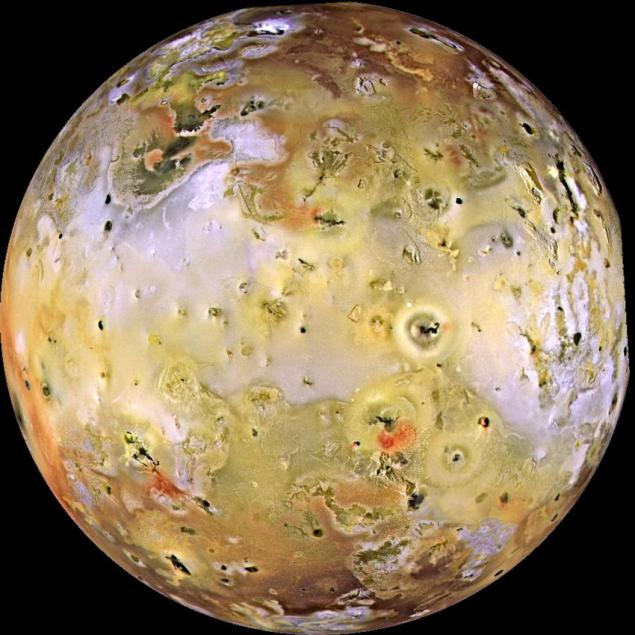
Cone Nebula
About Cone Nebula can be seen strange formations. They arise from the interaction of interstellar dust and gas, with the light coming from young stars. The blue glow around the star S Mon - is a reflection of the ambient light of a bright star stardust. The star S Mon is located in the scattered star cluster NGC 2264, located at a distance of 2500 light years from Earth. (Photo: Subaru Telescope (NAOJ) & DSS):
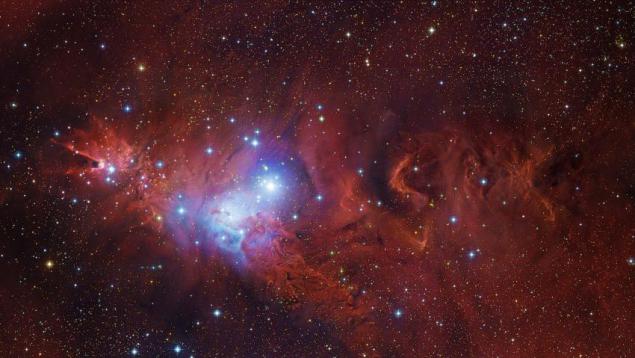
Spiral galaxy NGC 3370
The spiral galaxy NGC 3370 lies about 100 million light-years away in the constellation Leo. The size and structure it is close to our own Milky Way. (Photo: NASA, ESA, Hubble Heritage (STScI | AURA):
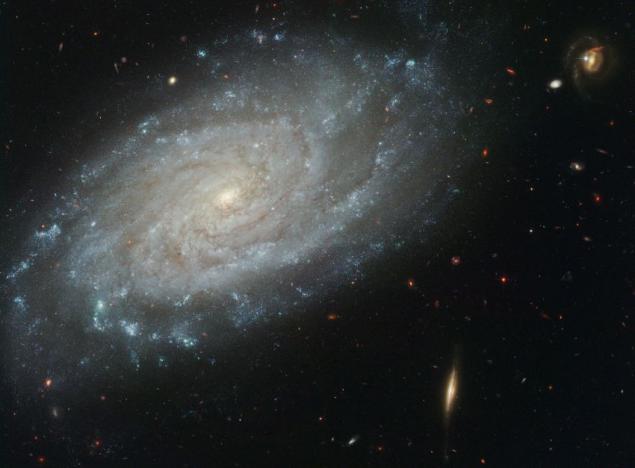
Spiral galaxy M74
This spiral galaxy is one of the photogenic. It consists of about 100 billion stars, and lies about 32 million light-years away. Presumably in this galaxy has a black hole of intermediate mass (ie, substantially more stellar masses, but less than black holes at the center of galaxies). (Photo: NASA, ESA, and the Hubble Heritage (STScI | AURA) - ESA | Hubble Collaboration):
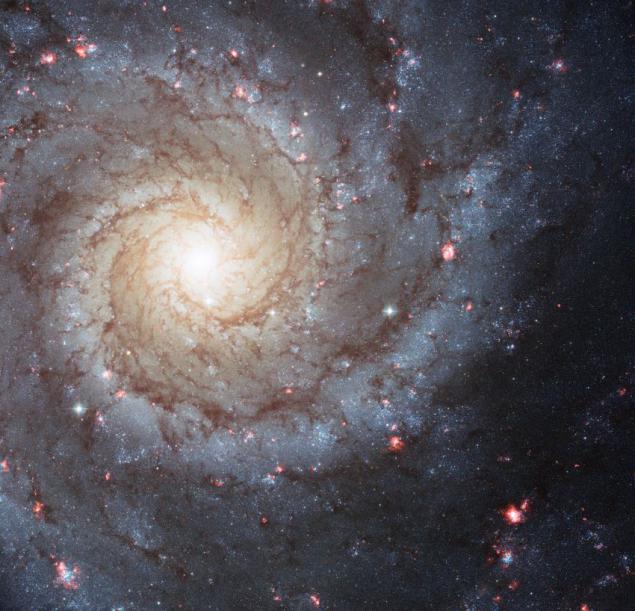
The Lagoon Nebula
It is a giant interstellar cloud and H II region in the constellation Sagittarius. Located at a distance of 5,200 light years, the Lagoon Nebula is one of the two nebulae zvezdoformiruyuschih poorly distinguishable to the naked eye in the middle latitudes of the Northern Hemisphere. Not far from the center of the lagoon is a bright area "hourglass" - the result of the turbulent interaction of stellar winds and powerful radiation. (Photo by Ignacio Diaz Bobillo):
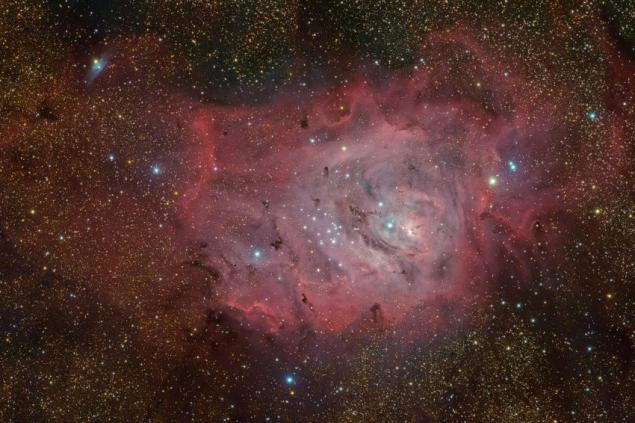
The luminous band in the Pelican Nebula
Well visible in the sky, the luminous band IC 5067 is part of a large emission nebula with a characteristic shape of the Pelican. The length of the strip - about 10 light-years, it outlines the head and neck of the cosmic pelican. Located at a distance of about 2000 light years from us. (Photo by César Blanco González):
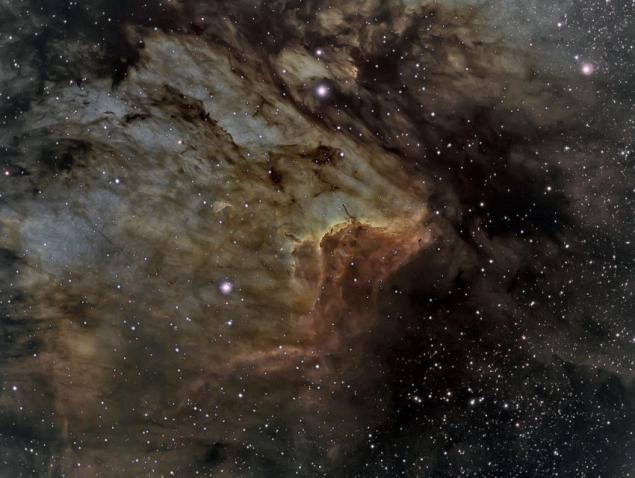
Thundercloud
This beautiful photograph was taken in the south of the province of Alberta in Canada. This removes the rain cloud, at its proximal end, showed unusual protrusions characteristic vymeobraznyh clouds, and from the far edge of the rain clouds. Also read the article "Rare species of clouds." (Photo by Alan Dyer):
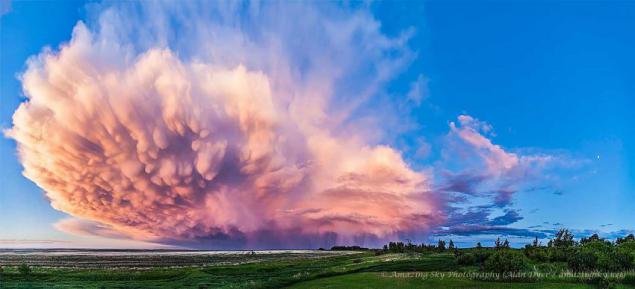
Three bright nebula in Sagittarius
The Lagoon Nebula M8 to the left of the image center, M20 - colored nebula on the right. Third Nebula, NGC 6559, is located just above the M8 and separated from it by a dark stripe stardust. All of them are at a distance of about 5000 light years from us. (Photo: Tony Hallas):
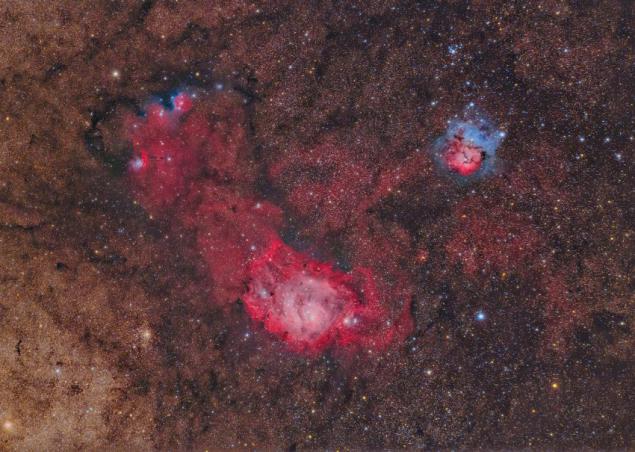
Galaxy NGC 5195: the question mark
Dwarf galaxy NGC 5195 in the constellation Canes Dogs is well known as a small companion spiral galaxy M51 - Whirlpool Galaxy. Together they look like a cosmic question mark, which is the point of NGC 5195. Located at a distance of about 30 million light years from Earth. (Photo Hubble Legacy Archive, NASA, ESA):

Amazing crab expanding
This Crab Nebula, located at a distance from us 6500 light years away in the constellation Taurus - supernova remnant, an expanding cloud of material left over after the explosion, a huge star. Currently, the size of the nebula - about 10 light years and is expanding at a rate of about 1000 km / s. (Photo by Adam Block, Mt. Lemmon SkyCenter, U. Arizona):
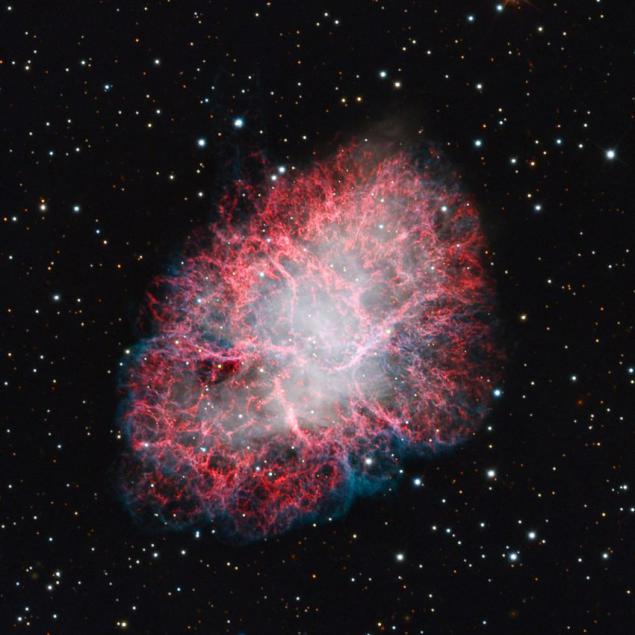
Variable Star RS Pup
This is - one of the most important stars in the sky. One of causality, it happens to be surrounded by the dazzling reflection nebula. The brightest star in the center - a throbbing RS Pup. It is almost 10 times more massive than the Sun, 200 times larger, and its brightness is an average 15 000 times more solar, and changes the brightness of RS Pup is almost five times every 41 days 4. RS Pup is located at a distance of about a quarter of the way between the Sun and the center of the Milky Way at a distance of 6500 St. years from Earth. (Photo Hubble Legacy Archive, NASA, ESA):
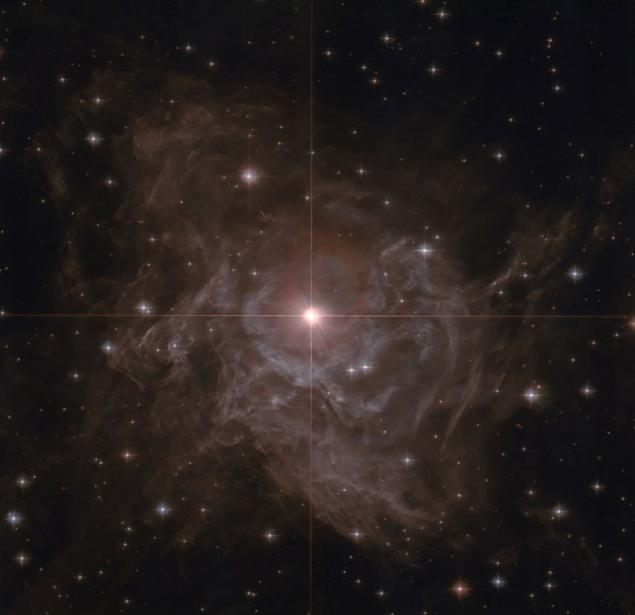
Ocean planet Gliese 1214b
The exoplanet (sverhzemlya) in the constellation Ophiuchus. First discovered ocean planet, it revolves around a dim red dwarf star GJ 1214. The planet is close enough to the Earth (13 parsecs, or about 40 light-years), and as the transits across the disk of its star, its atmosphere can be studied in detail using current technologies . One year on this planet lasts 36 hours.
The atmosphere of the planet consists of a thick water vapor with small amounts of hydrogen and helium. However, given the high temperature on the surface of the planet (about 200 degrees Celsius), scientists believe that the water on the planet is in such exotic states as "hot ice" and "superfluid water ', which are not found on Earth.
Age planetary system is estimated at several billion years. The mass of the planet is about 6, 55 Earth masses, while at the same time, exceeds the diameter of the planet Earth more than 2, 5 times. This picture shows how the artist imagines passing sverhzemli Gliese 1214b on the disk of its star. (Photo by ESO, L. Calçada):

Stardust in South Corona
There are visible cloud of cosmic dust, which are on the star field near the border of the constellation Corona Australis. They are located at a distance of less than 500 light-years away and block the light from the more distant stars the Milky Way galaxy. In the center of the image are several reflection nebulae. (Photo by Ignacio Diaz Bobillo):
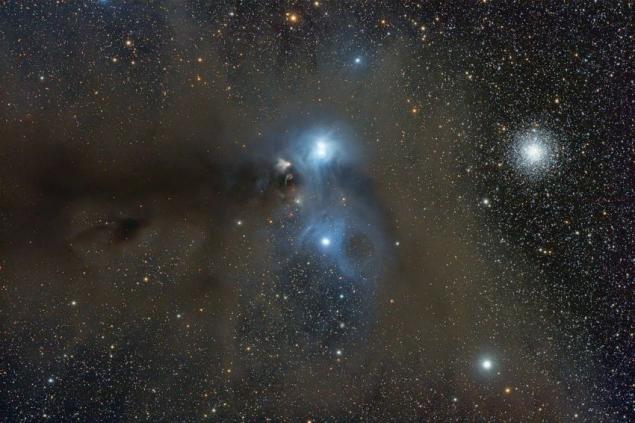
Galaxy Cluster Abell 1689
Abell 1689 - a cluster of galaxies in the constellation Virgo. This is one of the biggest and most massive known galaxy clusters is a gravitational lens, distorting the light of galaxies that lie behind it. The cluster is located at a distance of 2.2 billion light years (670 Mpc) from Earth. (Photo: NASA, ESA, Hubble Heritage):
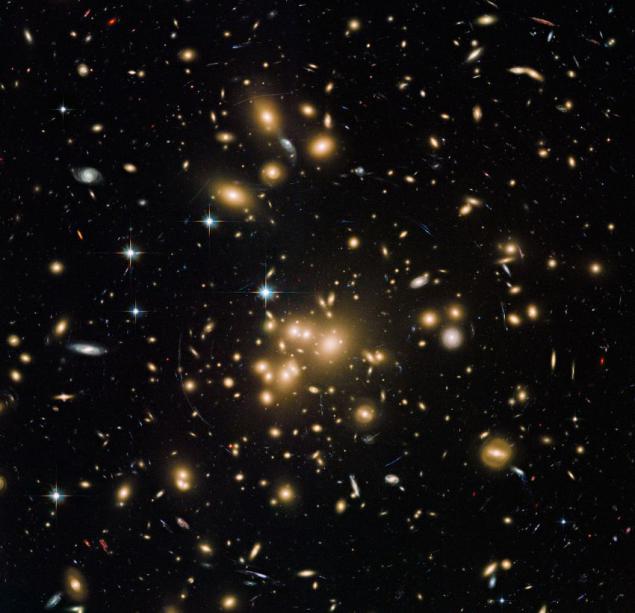
Pleiades
Open cluster in the constellation Taurus, sometimes referred to as the "Seven Sisters"; one of the closest to Earth and is one of the most visible to the naked eye star cluster. Perhaps this is the most famous star cluster in the sky. The Pleiades star cluster is about 12 light years in diameter and contains about 1000 stars. The total mass of stars in the cluster is estimated at approximately 800 mass of our sun. (Photo by Roberto Colombari):
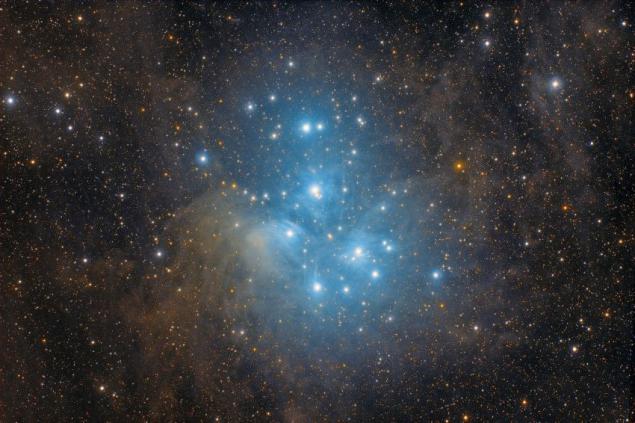
Nebula Shrimp
At sub-of Antares, in the tail of the nebula-rich constellation Scorpius, is an emission nebula IC 4628. Hot massive stars whose age is only a few million years, light nebula invisible ultraviolet light. Astronomers call this cosmic cloud nebula Shrimp. (Photo: ESO):
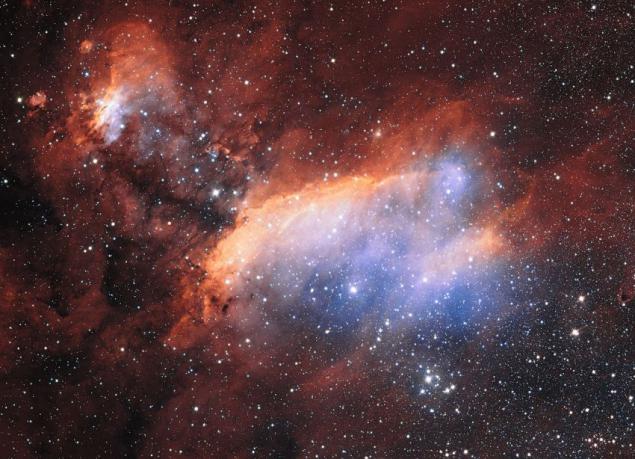
Source: asaratov.livejournal.com
Beautiful triple nebula NGC 6514 in the constellation of Sagittarius. The name of the nebula suggested by William Herschel and means' divided into three lobes. " The exact distance to it is unknown, but estimates range from 2 to 9000 light years. NGC 6514 is just three basic types of nebulae - Emission (pink color), reflecting (blue) and absorbing (black color). (Photo by Máximo Ruiz):

The cosmic elephant's trunk
Elephant Trunk Nebula winds through the emission nebula and young star cluster complex IC 1396 in the constellation Cepheus. Cosmic elephant's trunk is over 20 light-years. These dark clouds, like the mustache, contain material for star formation and hide protostars - stars in the final stages of its formation - the layers of cosmic dust. (Photo by Juan Lozano de Haro):

World-ring
Hoag's Object - a strange ring-shaped galaxy in the constellation Serpens, named after otkryvatelya.Rasstoyanie to Earth is about 600 million light years. In the center of the galaxy is a cluster of relatively older stars are yellow. It is surrounded by almost right ring of stars younger, with blue tint. The diameter of the galaxy - about 100 thousand. Light years. Among the hypotheses about the origin of the collisions of galaxies that happened billions of years ago. (Photo by R. Lucas (STScI | AURA), Hubble Heritage Team, NASA):

Moon Over Andromeda
A large spiral galaxy Andromeda is located only 2.5 million light-years away and is the nearest to our own Milky Way spiral galaxy. It can be seen with the naked eye as a small fuzzy patch in the sky. This composite picture compares the angular size of the Moon and the Andromeda Galaxy. (Photo by Adam Block and Tim Puckett):

The ever-changing surface of Io
Jupiter's moon Io - the most volcanically active object in the solar system. Its surface is constantly changing due to new lava flows. This photo side of Io, turned to Jupiter, it is composed of images taken in 1996 by NASA's Galileo spacecraft. The lack of impact craters because the entire surface of Io is covered with a layer of volcanic deposits much faster than the craters appear. The probable cause of volcanic activity is the changing gravitational tides caused by Jupiter huge. (Photo: Galileo Project, JPL, NASA):

Cone Nebula
About Cone Nebula can be seen strange formations. They arise from the interaction of interstellar dust and gas, with the light coming from young stars. The blue glow around the star S Mon - is a reflection of the ambient light of a bright star stardust. The star S Mon is located in the scattered star cluster NGC 2264, located at a distance of 2500 light years from Earth. (Photo: Subaru Telescope (NAOJ) & DSS):

Spiral galaxy NGC 3370
The spiral galaxy NGC 3370 lies about 100 million light-years away in the constellation Leo. The size and structure it is close to our own Milky Way. (Photo: NASA, ESA, Hubble Heritage (STScI | AURA):

Spiral galaxy M74
This spiral galaxy is one of the photogenic. It consists of about 100 billion stars, and lies about 32 million light-years away. Presumably in this galaxy has a black hole of intermediate mass (ie, substantially more stellar masses, but less than black holes at the center of galaxies). (Photo: NASA, ESA, and the Hubble Heritage (STScI | AURA) - ESA | Hubble Collaboration):

The Lagoon Nebula
It is a giant interstellar cloud and H II region in the constellation Sagittarius. Located at a distance of 5,200 light years, the Lagoon Nebula is one of the two nebulae zvezdoformiruyuschih poorly distinguishable to the naked eye in the middle latitudes of the Northern Hemisphere. Not far from the center of the lagoon is a bright area "hourglass" - the result of the turbulent interaction of stellar winds and powerful radiation. (Photo by Ignacio Diaz Bobillo):

The luminous band in the Pelican Nebula
Well visible in the sky, the luminous band IC 5067 is part of a large emission nebula with a characteristic shape of the Pelican. The length of the strip - about 10 light-years, it outlines the head and neck of the cosmic pelican. Located at a distance of about 2000 light years from us. (Photo by César Blanco González):

Thundercloud
This beautiful photograph was taken in the south of the province of Alberta in Canada. This removes the rain cloud, at its proximal end, showed unusual protrusions characteristic vymeobraznyh clouds, and from the far edge of the rain clouds. Also read the article "Rare species of clouds." (Photo by Alan Dyer):

Three bright nebula in Sagittarius
The Lagoon Nebula M8 to the left of the image center, M20 - colored nebula on the right. Third Nebula, NGC 6559, is located just above the M8 and separated from it by a dark stripe stardust. All of them are at a distance of about 5000 light years from us. (Photo: Tony Hallas):

Galaxy NGC 5195: the question mark
Dwarf galaxy NGC 5195 in the constellation Canes Dogs is well known as a small companion spiral galaxy M51 - Whirlpool Galaxy. Together they look like a cosmic question mark, which is the point of NGC 5195. Located at a distance of about 30 million light years from Earth. (Photo Hubble Legacy Archive, NASA, ESA):

Amazing crab expanding
This Crab Nebula, located at a distance from us 6500 light years away in the constellation Taurus - supernova remnant, an expanding cloud of material left over after the explosion, a huge star. Currently, the size of the nebula - about 10 light years and is expanding at a rate of about 1000 km / s. (Photo by Adam Block, Mt. Lemmon SkyCenter, U. Arizona):

Variable Star RS Pup
This is - one of the most important stars in the sky. One of causality, it happens to be surrounded by the dazzling reflection nebula. The brightest star in the center - a throbbing RS Pup. It is almost 10 times more massive than the Sun, 200 times larger, and its brightness is an average 15 000 times more solar, and changes the brightness of RS Pup is almost five times every 41 days 4. RS Pup is located at a distance of about a quarter of the way between the Sun and the center of the Milky Way at a distance of 6500 St. years from Earth. (Photo Hubble Legacy Archive, NASA, ESA):

Ocean planet Gliese 1214b
The exoplanet (sverhzemlya) in the constellation Ophiuchus. First discovered ocean planet, it revolves around a dim red dwarf star GJ 1214. The planet is close enough to the Earth (13 parsecs, or about 40 light-years), and as the transits across the disk of its star, its atmosphere can be studied in detail using current technologies . One year on this planet lasts 36 hours.
The atmosphere of the planet consists of a thick water vapor with small amounts of hydrogen and helium. However, given the high temperature on the surface of the planet (about 200 degrees Celsius), scientists believe that the water on the planet is in such exotic states as "hot ice" and "superfluid water ', which are not found on Earth.
Age planetary system is estimated at several billion years. The mass of the planet is about 6, 55 Earth masses, while at the same time, exceeds the diameter of the planet Earth more than 2, 5 times. This picture shows how the artist imagines passing sverhzemli Gliese 1214b on the disk of its star. (Photo by ESO, L. Calçada):

Stardust in South Corona
There are visible cloud of cosmic dust, which are on the star field near the border of the constellation Corona Australis. They are located at a distance of less than 500 light-years away and block the light from the more distant stars the Milky Way galaxy. In the center of the image are several reflection nebulae. (Photo by Ignacio Diaz Bobillo):

Galaxy Cluster Abell 1689
Abell 1689 - a cluster of galaxies in the constellation Virgo. This is one of the biggest and most massive known galaxy clusters is a gravitational lens, distorting the light of galaxies that lie behind it. The cluster is located at a distance of 2.2 billion light years (670 Mpc) from Earth. (Photo: NASA, ESA, Hubble Heritage):

Pleiades
Open cluster in the constellation Taurus, sometimes referred to as the "Seven Sisters"; one of the closest to Earth and is one of the most visible to the naked eye star cluster. Perhaps this is the most famous star cluster in the sky. The Pleiades star cluster is about 12 light years in diameter and contains about 1000 stars. The total mass of stars in the cluster is estimated at approximately 800 mass of our sun. (Photo by Roberto Colombari):

Nebula Shrimp
At sub-of Antares, in the tail of the nebula-rich constellation Scorpius, is an emission nebula IC 4628. Hot massive stars whose age is only a few million years, light nebula invisible ultraviolet light. Astronomers call this cosmic cloud nebula Shrimp. (Photo: ESO):

Source: asaratov.livejournal.com
Tags
See also
Photos from space, photographer cosmonaut Oleg Germanovich Artemyev (28 photos)
Together forever.
12 tips from professionals on how to achieve stunning results on the phone
Fun fact of the day: a person without a bee can not survive
The sense of death
A selection of very interesting and informative facts about the planet Mars.
10 exciting professions
15 interesting facts about the movie "The Amazing Spider-Man"
Figures rain
Lily Collins and the best year of her wardrobe















